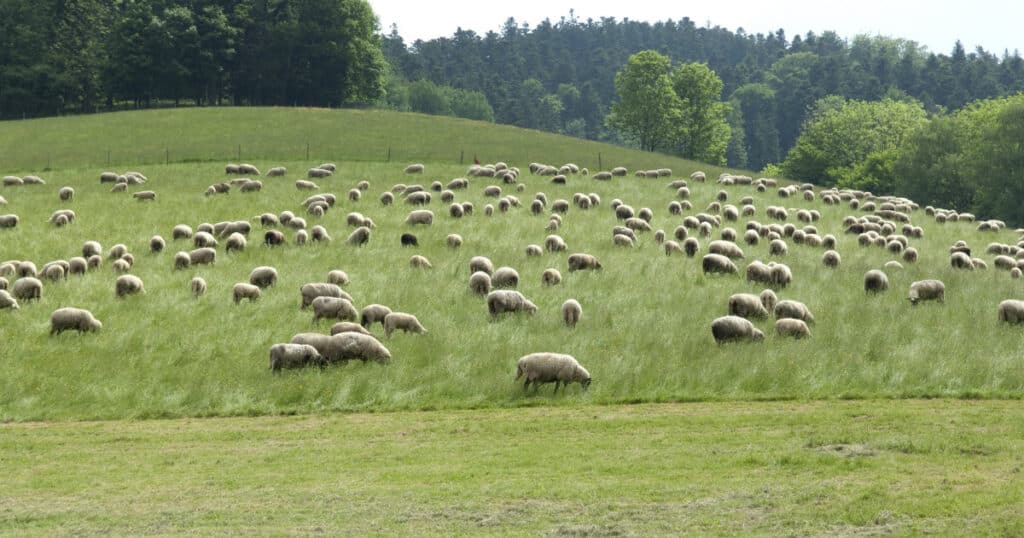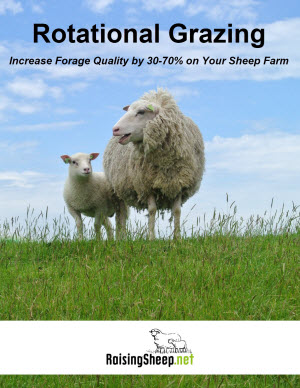Grass or pasture is the primary source of food and nutrients for ruminant mammals like sheep. Because of sheep’s unique digestive system, farmers need to ensure that their stock can safely graze while minimizing feed costs and damage to the pasture. This article covers the basics of pasture management for sheep farming. I’ll introduce you to the basic concepts of pasture management, explain what it is, why it’s important, and provide some essential tips to help you improve the grasslands on your sheep farm.
Let’s get started.
What is Pasture Management?
Pasture management for sheep involves several strategies and practices to ensure that natural and suitable forage is available for sheep to graze on. Good pasture management practices affect the health and sustainability of farm operations and the surrounding ecosystem. When a pasture is well-managed, it can produce high-quality feeds, improve forage growth and yield, decrease weed and pest infestation, and enhance the health and productivity of sheep.
Get Your FREE Rotational Grazing Guide
This 16-page PDF is packed with our best information and tips to start increasing forage quality 30-70% in your pasture.
- Discover the science behind rotational grazing.
- Learn how you can improve forage quality and quantity.
- Discover creative ways you can manage your grasslands.
- Get helpful tips that can help you cut feed costs for your flock.
- Understand the trade-offs in switching to rotational grazing.
What Factors Affect Pasture Management?
There are several significant factors to consider so you can grow and manage pastures successfully. These include:
- Soil quality,
- Climate,
- Terrain, and
- Water Supply
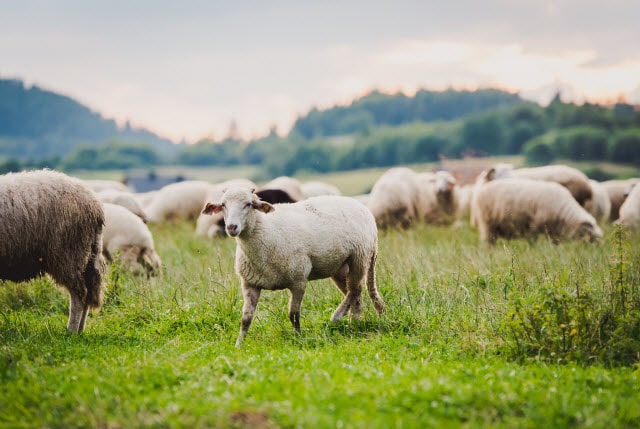
Let’s take a closer look at each of these environmental factors and the roll it plays in managing your sheep pasture.
Soil Quality
Soil provides the groundwork for pasture management. Fertile soil allows grass to grow in adequate quantities, hence sustaining the feeding requirements of a flock. Good quality soil will not erode easily and will also ward off the growth of undesirable weeds and poisonous plants.
To determine if the soil is conducive for pasture growth, soil testing is typically done. Soil samples are taken from several areas of interest to get a representative sample. Once the samples are collected, they undergo testing in a lab where factors such as the Ph level, available phosphorous and potassium, and presence of salt and cations such as calcium, sodium, and magnesium are analyzed.
Soil testing and analysis will help reveal what nutrients are available in the soil and what types of plants can thrive in your pasture. The results of soil testing also provide recommendations on which fertilizers can improve soil fertility, though on most sheep farms the sheep do most of the fertilizing.

I have used and recommend this online soil test kit from Amazon. You dig up a few samples and ship it to a lab in the provided box. When results are ready you can access an online dashboard where your soil is fully analyzed and the information will remain available to you any time you need to reference it.
Climate
Weather can affect pasture growth and development. Grass can grow more quickly during the warmer months, as long as there is ample moisture. However, during periods of extreme drought, forage yield is typically low because there is a shortage in the water supply that can help the grass survive.
Grass production may also be lower during the early stages of the rainy season, where the volume of precipitation is high. During intense rainfall periods, water runs off the soil rather than being absorbed, making the soil less conducive to grass growth.
Terrain
The location of the pasture, the level of terrain, and the steepness of its slope can affect livestock grazing behavior and pasture development.
For example, sloping terrains that face south receive more sunlight than north-facing slopes, enabling them to produce better grass. Steep, sloping terrains are less favorable to forage growth because they are shallow and prone to erosion compared to the terrain at hillsides.
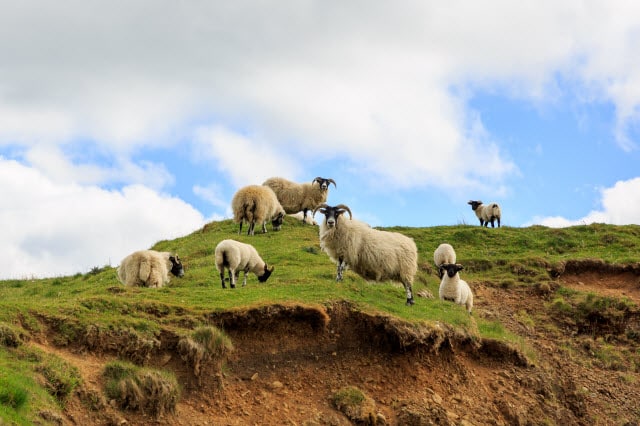
Livestock may also prefer grazing on flat or mild sloping terrains than steep ones.
Other land conditions such as deep ravines and uneven or unstable terrain may be dangerous to livestock. It’s important to have an understanding of the terrain and grazing conditions you’re offering your sheep. On a hilly property your flock may need more paddock space than a similar sized flock on level grassland.
Water Supply
Water quality and availability are vital in any livestock or farming operations. Without an ample supply of water, the land will not receive the moisture it needs to nurture crop growth. Likewise, a low water supply can also affect the health of the flock. Ideally, two to three gallons of water must be allocated per sheep.
If the pasture is located near urban or suburban areas, the existing drainage systems and water runoff patterns can also affect the water supply in pastures.
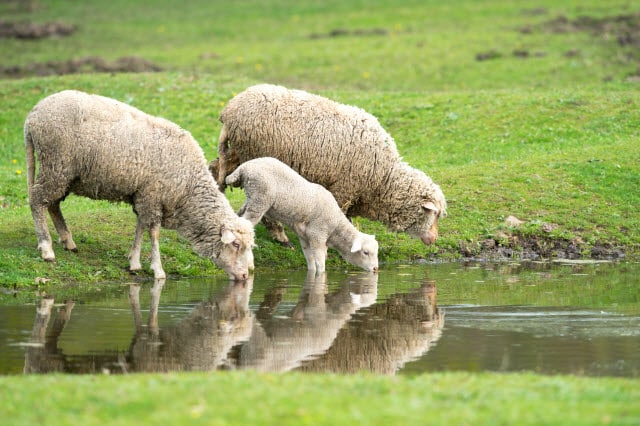
You’re in luck if your grassland has natural, clean water available to sheep. But if your pasture does not have a natural source of water you’ll have to provide access to clean fresh water in every paddock for your sheep.
If you’re dividing your pasture up into paddocks for rotational grazing, locating your water tank in the center of the pasture is a good way to cut down on labor … you can rotate them in a pinwheel around the field, retaining access to the water tank from each paddock set up with electric sheep netting.
What Types of Forage are Suitable for Sheep?
As a herbivore and ruminant, a sheep’s diet is mainly composed of plants, hay, and grains.
Sheep can graze for up to seven hours a day, especially on abundant pasture.
Forage selection depends on the climate and land conditions where the pasture is located. To ensure that sheep can feed year-round, forages should ideally be a mix of different crops. Sheep often prefer grazing on the following:
- Legumes,
- Grass, and
- Forbs
Let’s start with a few examples of the best types of forage in each of these categories.
What are Legumes?
Legumes can convert atmospheric nitrogen to ammonia, then add it to the soil for its development. They also have a high protein content.
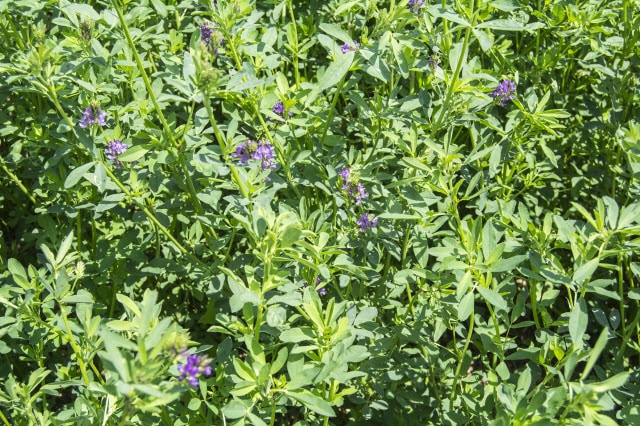
A few of the most common examples you’ll find in high quality sheep pasture are:
- Alfalfa – Alfalfa is one of the most common types of legumes found in dairy regions. It has a high crop yield and can survive for about six years. It is good for grazing because it grows tall and straight. However, it may be too rich for sheep to feed, so mixing it with 50% grass can be more effective.
- White clover – White clover is easy to grow and drought tolerant. However, the common types of white clover typically grow about two to three inches tall only, which are not suitable for grazing. Medium or Dutch types of white clover are ideal for sheep because they can grow up to eight inches tall.
- Red clover – Red clover grows faster and produces a high yield. It is also high in nutritional value, but it must be consumed with other crops or grasses because it may cause bloating.
Other legume options are Lespedeza and bird’s foot trefoil, which are legumes that bloom during the middle of the summer and early fall seasons. Vetch, lucerne, and alsike clover are other kinds of legumes that sheep can eat.
Grasses in Sheep Pasture
While sheep consume a higher volume of legumes, they also like eating grass. Ideally, pastures should be a mix of 70% legumes and 30% grass, but in most farm pasture you’ll find the inverse to be true.
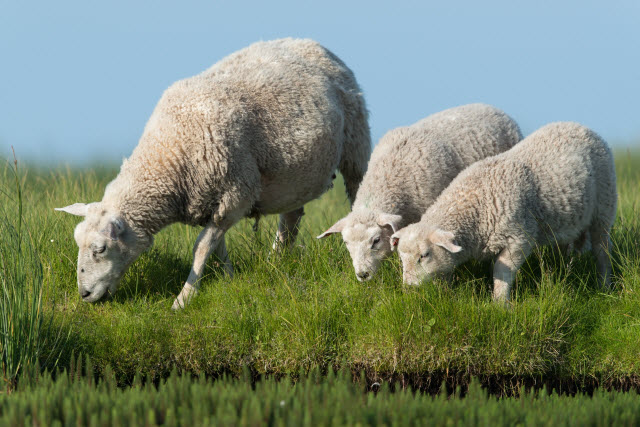
- Kentucky bluegrass – Kentucky bluegrass is one of the most commonly used types of grass in sheep pastures because it has a high tolerance for traffic, drought, floods, and overgrazing. This type of grass also grows up to 24 inches high and produces high-quality forage.
- Timothy – Sheep like eating timothy grass, however, it is a low-yielding crop and survives for about three to five years. It also needs cool, wet soil to grow.
- Perennial Ryegrass – Perennial ryegrass is easy to grow and produces high-quality grass. However, it only grows in early spring or late fall, and then dies out when winter comes.
Sheep can also eat other types of grass such as orchard grass, tall fescue, reed canary, and smooth bromegrass.
What are Forbs?
Other than legumes and grass, sheep also feed on plants called forbs. Forbs are plants that have broad leaves and can produce flowers. These plants provide a nice variety for sheep and tend to be some of the first plants sheep will consume in your pasture due to their high nutrient and moisture content.
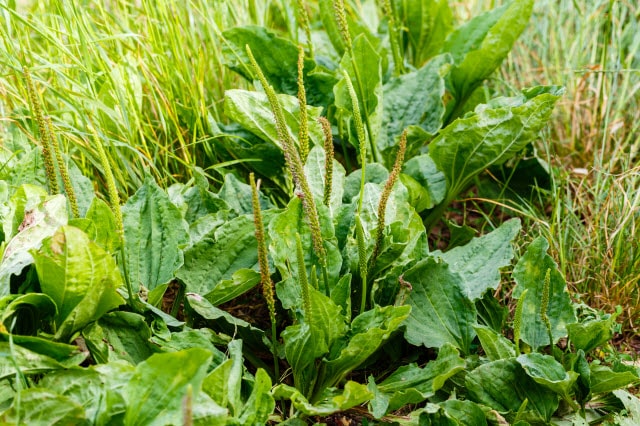
- Chicory – Chicory is nutrient-rich and is ideal for feeding lambs. Sheep will eat its tips and blossoms but will leave the tough stalks behind. It should be grown with legumes, as it will provide nitrogen that can help prevent competition from other weedy species of plants.
- Perennial sow thistle – Perennial sow thistle is a deep-rooted plant that can grow in many seasons. It is palatable to both cattle and sheep, with sheep favoring its leaves, flowers, and stalks.
- Broadleaf plantain – Broadleaf plantain is a perennial plant that is easy to grow even in high-traffic areas. Its leaves grow close to the ground and can reach up to six inches in length. Sheep likes to feed on this plant’s leaves and flowering stalks.
Other forb types that sheep like to eat are the common mallow, some dandelion varieties, and deciduous trees and shrubs like peach and willow. However, sheep only consume the leaves, flowers, and tips as the stems are too tough and fibrous for them to chew and digest.
How to Manage Sheep Pastures Effectively
Pasture management practices need to be carried out not only to sustain the health of forage but also of the soil and the livestock that feed on it.
Maintain a Light Stocking Rate
Stocking rate refers to the relationship between the size of grazeable forage and the number of sheep. It is often used interchangeably with stock density, but they are two different terms. Stocking density is the number of livestock that grazes on a certain area or portion of land at a particular time.
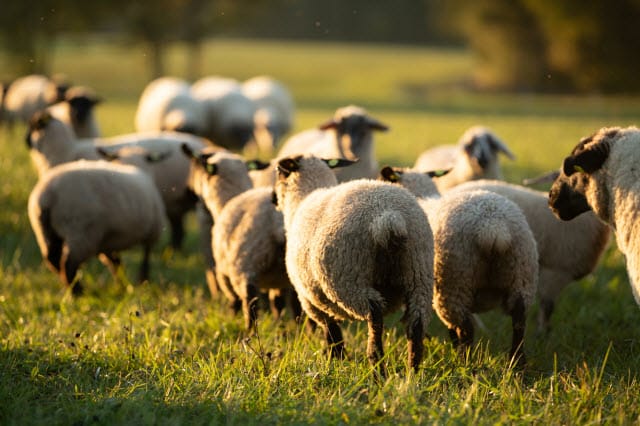
In pasture management, it is essential to understand that a portion of land can only support the grazing needs of a certain number of livestock. For sheep, the ideal stocking rate is six to ten sheep per acre of grass.
However, you should also consider factors such as the climate, terrain, and quality of forage when maintaining a stocking rate. A sustainable stocking rate can have a positive effect on forage production and quality and animal health and performance.
Select and Plan Pasture Grazing Strategies
There are several grazing methods that you can execute:
Rotational Grazing
This method involves dividing the entire pasture into smaller paddocks and allowing sheep to graze on the small subdivisions one period at a time. Rotational grazing allows your crops to rest and regrow, builds soil fertility, and ensures that you can grow sufficient and high-quality forage. Ideally, the period of rotations should be six to eight weeks.
Controlled Grazing
In controlled grazing, you determine how long your animals can graze on a certain area of the pasture and when it is time to remove them from that area. This grazing method offers many advantages, including better control on overgrazing sheep, stretching the availability of resources, and preventing the consumption of less nutritious plants.
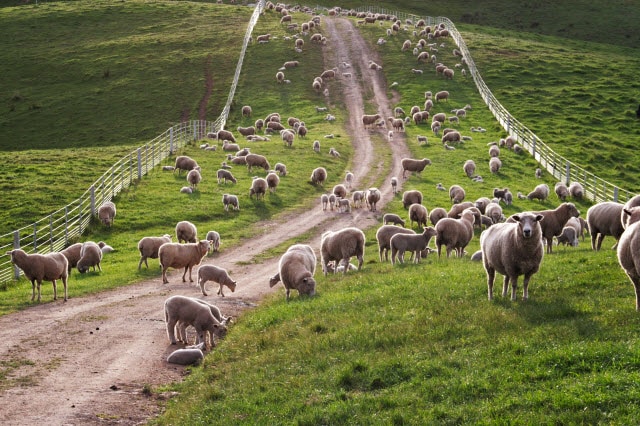
Continuous Grazing
In this system of grazing, you allow sheep to constantly have access and graze on a specific portion of the land throughout a set period. This grazing method can let you save on fencing and water costs, but since you allow the animals to choose which area to feed on, it can also result in both overgrazed and underutilized forage.
Multi-Species Grazing
If you have other livestock, like cattle, in your pasture, you can opt for multi-species grazing. Because of the different grazing behaviors and types of plants animals eat, this method may require additional costs for labor and resources. However, it also has advantages. Mixing cattle with sheep can prevent threats from sheep predators. It can also help in parasite control in your sheep flock and suppress weeds in your pasture, as some parasites and weeds may be harmful to sheep and not to cattle, and vice versa.
Forward Grazing
This grazing system is also called first-last or leader-follower grazing. In this method, you will allow animals with higher nutritional needs to graze first, followed by those with lesser nutritional needs. Like multi-species grazing, this method can help impede the life cycle of parasites and reduce forage wastage.
Mob Grazing
Also known as high-density grazing, this system involves allowing a large number of livestock to graze on a small area for a short period. Grazing periods are usually two to three times a year, which allows ample time for crops to grow, increase soil fertility, and reduce weed growth.
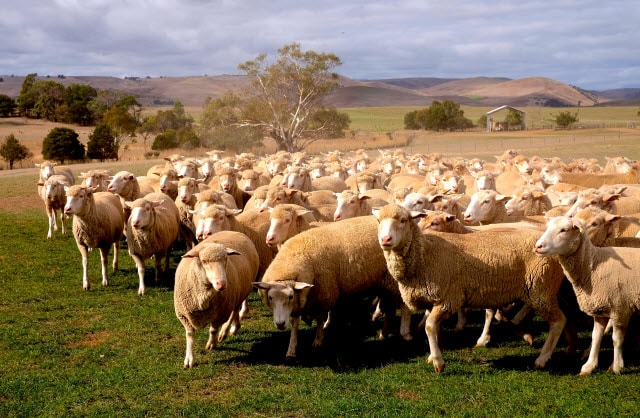
Creep Grazing
In creep grazing, young animals graze on the most nutritious portion of the land. Creep grazing requires a small area. Doing this aims to supplement their mother’s milk, therefore, reducing the needed energy and resources for the mother to produce milk for their young.
Strip Grazing
Strip grazing involves fencing a part of the pasture so that animals can only graze on the areas within the fence for a limited time. This method helps reduce crop wastage and animal selectivity. It can also allow forage to rest, recover, and grow.
Manage Manure Properly
At times in life everyone feels that managing manure is all we do … but kidding aside, developing a manure management system not only ensures your homestead is sanitary, but can also contribute to the improvement of soil stability and increase of water retention capabilities of the soil.
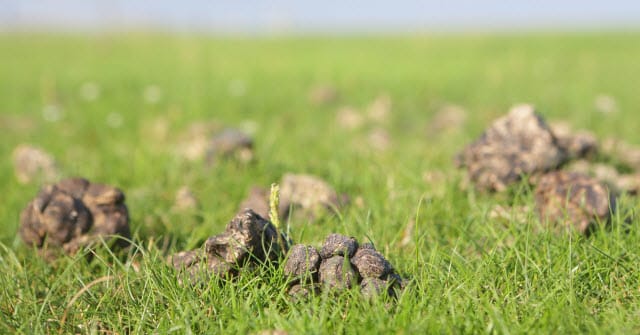
Sheep manure contains many nutrients, and with the proper management techniques, can enrich the soil and boost plant growth. Here a few things to keep in mind:
- Maintain the ideal level of stock density.
- In case more manure is produced than needed for soil enrichment, stockpile or store excess manure properly until it is needed.
- Don’t overstock as it may affect the quality of your water supply.
- Be vigilant that manure does not leach past root zones and reach nearby water surfaces.
- Test manure nutrient content to see if it will address the nutrient requirements of the soil.
- Compost manure to get rid of parasites before spreading it on the soil.
Develop Weed Control Strategies
Weeds compete against the forage for nutrients so you must implement measures to prevent weeds and other undesirable plants from growing in your land. Some weeds are also toxic and can affect the health and productivity of your livestock.
In sheep grasslands I consider weeds to be anything that is toxic to sheep, or anything that they won’t (or don’t) eat. If sheep avoid specific plants, those are the plants that are left to grow tall and go to seed, ensuring there will be more of them in your pasture crowding out high quality forage.
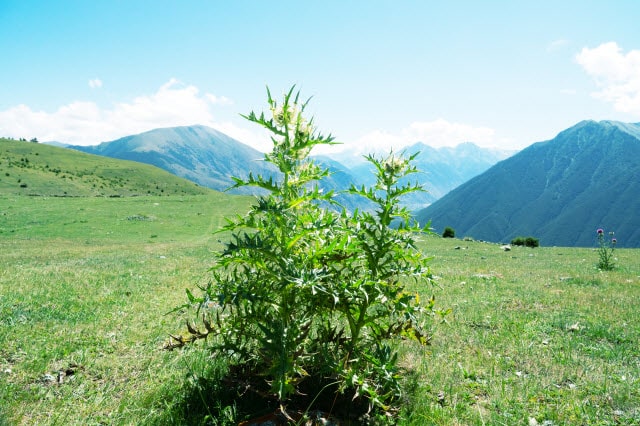
Below are some measures that you can implement to control and prevent weed growth:
- Check for the soil’s pH level as some weeds tend to grow on acidic soils.
- Consider pasture rotation, as it provides time for forage to rest and recover.
- Consider multi-species grazing so other animals can graze on the weeds.
- Mow or clip after grazing to reduce weed seeds.
- Seed thin or bare spots.
- Try spot treatment with chemicals or herbicides.
Establish Parasite Control Measures
Parasites are ever-present in an animal’s ecosystem. The best way to tackle them is to ensure that your landscape does not provide the right conditions for them to grow, and to adopt an effective deworming schedule on your farm.
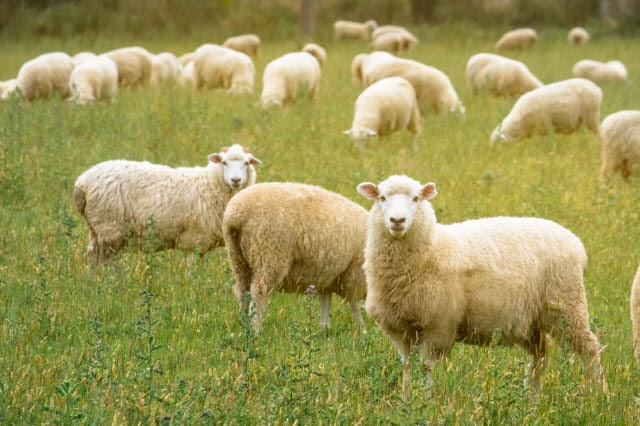
It can be a challenging task, but it is possible to reduce the chances of parasite breeding on your pasture, and to disrupt the life cycle of internal parasites. This starts with the following sheep pasture management practices:
- Allow adequate time for forage to rest in between grazing periods.
- Don’t let animals graze on short grass. Parasites can crawl up to two inches of grass or plants from the ground.
- Multi-species grazing can help eliminate parasites that can harm sheep. Consider mixing cattle, chickens, or Muscovy ducks for cleaning pasture of parasites.
- Monitor animal health and check for signs of infection.
The Key to Effective Pasture Management for Sheep? You.
Too often I see shepherds on small farms destroying their pasture by overgrazing. Allowing your sheep to remain on your pasture when they’ve eaten every blade of grass ensures that your paddock will be nothing but dirt for years.
Take it upon yourself to learn about rotational grazing and other strategies to help you make the most of your land and reduce the amount of money you spend each year on hay and grain for your flock. I have a free eBook on the subject which is a great place to start.

